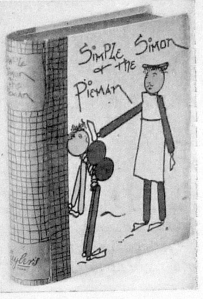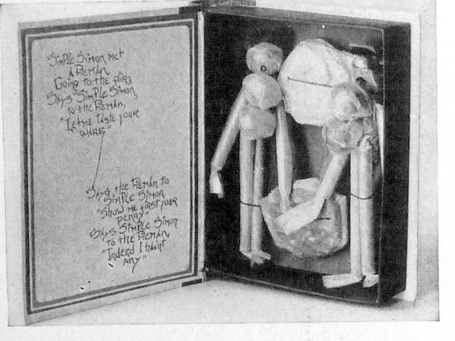This is the first post of a Blook Club Feature. If you go to the Blook Club Page of this blog you will see a list of the people who have generously contributed to my collection. You too can be a member of the Club by donating blooks, published references, and scholarly input. I would also welcome your assistance in building the collection through financial contributions, should you be so generous to want to help. Each donated blook will recieve a Blook Club Feature Post. (I also hope to do this retrospecively in order to thank everyone who has contributed to date).
Here is an example of a very interesting object that was given to me by Tom Bodkin. I don't know the circumstances in which he found it but I'm very happy that he did. Upon acquisition, I conducted a bit of research and discovered its surprising historical significance. It is the first first-aid kit produced specifically for the automobile! It's had a hard life and is a little beat up, but fortunately all of its contents and design elements still exist.
 |
| Photograph by Richard Minsky |
 |
| Photograph by Richard Minsky |
The Exide First Aid Case. Long Life by Exide; with a quote by Charles Dickens
Exide Battery Corp.
English, c. 1937
Tin, cloth, gold foil, miscellaneous first aid materials
20.8 x 13.3 x 4.7 cm (8.2 x 5.2 x 1.9 in)
This copy is very water damaged, but one can still see that the binding
is covered in brown pebble and morocco grain bookcloths, and it is stamped
in gold on the spine with Long Life by Exide. On the front cover there is a Dickens quote: Grief never mended no
broken bones and as good people’s wery scarce, make the most on ’em (from Sketches by Boz, 1836).
Here is the text from the original press release describing it. Reference: The World’s Carriers and Carrying Trades’ Review. Vol. XXXIV-No. 397; October 15, 1937. November 4, 1937, p. 110:
Here is the text from the original press release describing it. Reference: The World’s Carriers and Carrying Trades’ Review. Vol. XXXIV-No. 397; October 15, 1937. November 4, 1937, p. 110:
“Exide” First Aid Kits.
The Exide Press
Luncheon held at the Clarendon Restaurant on October 14th, was
chosen by the Exide Company as the occasion on which to introduce a scheme to
meet a motoring necessity which has long been neglected or overlooked.
With road casualty figures increasing annually—it is surprising that the percentage of cars carrying first aid kit could probably be put as low as one in a hundred. Hasty work on a roadside adjustment generally results in skinned knuckles or a cut hand which need immediate attention if dangerous conditions are to be averted, and for these reasons alone the kits are sure of an enthusiastic welcome by motorists.
With road casualty figures increasing annually—it is surprising that the percentage of cars carrying first aid kit could probably be put as low as one in a hundred. Hasty work on a roadside adjustment generally results in skinned knuckles or a cut hand which need immediate attention if dangerous conditions are to be averted, and for these reasons alone the kits are sure of an enthusiastic welcome by motorists.
We were impressed by the ingenious adaption of the famous Exide slogan, “Long Life,” printed on the spine of a “book” which opens and reveals the contents neatly and compactly arranged inside.
Distribution of the kits will be directed through the Exide organisation of 600 Service Agents, and it is hoped eventually to reach every motorist by means of the Company’s association with the retail motor trade.
Each kit contains one bottle of iodine, one bottle of smelling salts, one bottle of burn lotion, one bottle of sal volatile, one phial of aspirins, one pair of scissors, one roll of adhesive plaster, one packet of gauze, three rolls of bandage (1 in., 2 ins. and 3 ins.), one packet of cotton wool, one packet of surgeon’s lint, twelve safety pins in a box, one tin of pure white Vaseline, one pair of tweezers; and a scheme is in operation which enables the Company to sell the kits at 3/6 each.
Exide aims at a “first-aid kit for every car,” and they are to be congratulated on their initiative in being the first concern intimately associated with the motoring industry to sponsor a plan which meets an urgent need.
An aside: I can't believe we have to put up with those unattractive plastic first-aid cases, why can't we have bookish first aid kits these days? It will probably show up soon as another Project Page. If you make one, please send a picture.























